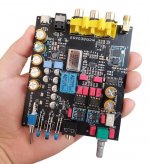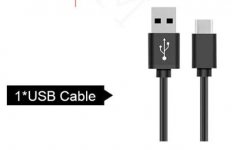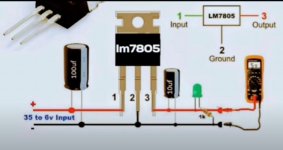I have a little DAC on order that uses a USB C jack on the back for power. Is there any real benefit to be had by using something other than a standard 120V to 5V USB adapter that I have on hand from an external HDD that also needed USB power? I think it cost less than $10. A regulated 5V supply designed for the purpose is expensive - as much as the DAC itself. I will be trying the DAC in a hi-fi system, not for computer audio. Suggestions? Thanks.
Interesting. A guy put some USB phone chargers on an oscilloscope to check for various quality issues:
https://www.righto.com/2012/10/a-dozen-usb-chargers-in-lab-apple-is.html
A friend has a genuine Apple USB charger that he doesn't need, and I will be plugging it into a Furman power filter with noise filtration and surge protection. Maybe that will be sufficient. 🙂

https://www.righto.com/2012/10/a-dozen-usb-chargers-in-lab-apple-is.html
A friend has a genuine Apple USB charger that he doesn't need, and I will be plugging it into a Furman power filter with noise filtration and surge protection. Maybe that will be sufficient. 🙂
I have had decent results doing just that using a 9v dc wall wart, with an LM7905, capacitors similar to datasheet. Didn’t cost much, as the used regulator was in my spares, as were the caps.
As far as switching supplies that are readily available, the apple ones aren’t too bad.
As far as switching supplies that are readily available, the apple ones aren’t too bad.
The scope's useful at examining the normal-mode noise but useless at showing common-mode noise. Its the latter that's no less important than the former when SQ is a concern but its much more difficult to filter out. An inductor or two and a few lowESR caps will get rid of the normal-mode noise. Here are a couple of normal-mode noise filters I built recently to filter SMPSUs for feeding DACs :Interesting. A guy put some USB phone chargers on an oscilloscope to check for various quality issues:
The scope's useful at examining the normal-mode noise but useless at showing common-mode noise. Its the latter that's no less important than the former when SQ is a concern but its much more difficult to filter out.
Nevertheless, I think his various tests were an indicator of the relative quality of the units, which was the purpose of the article. I am assuming my power "conditioner" will take out a lot of other AC line noise:
https://furmanpower.com/product/15a-classic-series-power-conditioner-w-lights
I have been using it for a while for everything but my power amplifiers. It has protected my system several times over the years when it detected a problem with the AC power. We do get some nasty glitches here once in a while.
Power Supply: USB C Port, 5V (2A or above) Hmmmmmm ... I wonder if this little DAC really needs 2 amps? If my friend is sending me the little 5 watt Apple charger, that's only rated at 1 amp, as is the cheap one that I have in my hands now. One buyer did comment, "Works with 1 amp phone charger." Comes with the USB cord shown. I think that's type A USB 2.0 to type USB C correct? Was USB 2.0 ever rated to deliver 2 amps or higher?
Attachments
Last edited:
But it's free since it's sitting on my shelf. 🙂ATX supply is overkill.
I asked the seller, and the actual current draw is only 0.4 amps. I figured it couldn't be very much.
If anyone has built a DIY high quality power supply for a USB C device, I'd like more info on how you did it. 5 volts, device draws 0.4 amps.
Go look at post #4 and use lm7805, not lm7905 like I had written before.
If that isn’t in the cards, then maybe get this;
https://www.ebay.com/itm/3347244791...6F0MbmLWAkiwLBDETiTGALzgmg|tkp:Bk9SR7baxZDQYQ
If that isn’t in the cards, then maybe get this;
https://www.ebay.com/itm/3347244791...6F0MbmLWAkiwLBDETiTGALzgmg|tkp:Bk9SR7baxZDQYQ
Go look at post #4 and use lm7805, not lm7905 like I had written before.
Like this? What value caps would you recommend? Any additional items you would add to the circuit for the best noise filtering for audio applications? I'm not an engineer. Totally novice.
Attachments
I asked the same question over on the audiosciencereview forum, in reference to the Topping E50 DAC. One of the Topping engineers, John Yang, answered that a good quality phone charger is all that's needed -Is there any real benefit to be had by using something other than a standard 120V to 5V USB adapter
https://www.audiosciencereview.com/...review-balanced-dac.26219/page-14#post-898318
John Yang is alluding to the fact that Topping's internal power circuitry already cleans up dirty incoming DC power, so you can get away with using any power supply. Of course this may not necessarily hold true for all DAC's, particularly cheaper models.
Is your DAC Topping? If not, I like abraxalito's idea of using a standard 5V wall-wart, then adding inductors + caps before the 5V gets to your DAC. I suspect Topping DAC's include something similar.
Or if you want to go full linear power supply, without the extreme cost of a commercial audiophile product, I think LT1963A is good as a pre-regulator (and much better than LM7805). A DIY regulator board of this type is $12 -
https://www.ebay.com.au/itm/LT1963A...or-decoding-preamplifier-coaxial/273820995058
then you would just need a 5VAC transformer; I like flat-pack transformers for this type of application (though it can be fiddly to make up a mounting board for them) -
https://catalog.triadmagnetics.com/...nt-flat-pack-power-transformers-1/fp10-1200-1
otherwise this is a good chassis-mount model -
https://catalog.triadmagnetics.com/...orld-series-power-transformers-1/vps10-2500-1
Is your DAC Topping?
No, it's an extremely cheap Chinese DAC with four OPA1612 Op-Amps in it. I have to say that it does sound pretty good IMHO after 1 day of listening to it with my modified Dynaco ST-70 series ii. I have it plugged into an old Apple 5 volt 1A USB charger that a friend gave me. That is plugged into a Furman PL-8C power filter. Not sure if there would be any additional benefit or not, but it's a cheap DIY project I guess.
I'd agree with John Yang if its the Topping's balanced outs being used. However CM noise will impose itself across the shields of SE cables if the SE outputs are the ones employed.I asked the same question over on the audiosciencereview forum, in reference to the Topping E50 DAC. One of the Topping engineers, John Yang, answered that a good quality phone charger is all that's needed -
https://www.audiosciencereview.com/...review-balanced-dac.26219/page-14#post-898318
John Yang is alluding to the fact that Topping's internal power circuitry already cleans up dirty incoming DC power, so you can get away with using any power supply. Of course this may not necessarily hold true for all DAC's, particularly cheaper models.
Yep, that’s all you need, just have a dc supply of around 9v/1 amp to supply that and you’re good. The lm7805 data sheet is a good resource too.Like this? What value caps would you recommend? Any additional items you would add to the circuit for the best noise filtering for audio applications? I'm not an engineer. Totally novice.
Standard type caps will be fine, Nichicon are good. The Nichicon FW are decent without spending more than you need.
I have several supplies like that in various pieces of equipment, wired point to point and no circuit boards. Try and protect the caps and connections from shorting but leave the lm7805 exposed for cooling.
Disclaimer; this isn’t touted as being any super hi-fidelity setup, just basic and decent for the application.
7805 has excellent noise and ripple rejection, I believe.
Or simply add filter to phone charger.
USB C phones need 2 Amp supplies, USB 2 phones get away with 1 Amp supplies.
So if you have an old charger, just use a filter to reduce switching noise.
Linear supplies...see above, use a supply at least 2V above output to allow the regulator to work, the next common rating is 9V, even 12V will work.
Add a heat sink to the regulator...
Or simply add filter to phone charger.
USB C phones need 2 Amp supplies, USB 2 phones get away with 1 Amp supplies.
So if you have an old charger, just use a filter to reduce switching noise.
Linear supplies...see above, use a supply at least 2V above output to allow the regulator to work, the next common rating is 9V, even 12V will work.
Add a heat sink to the regulator...
- Home
- Source & Line
- Digital Source
- Power upgrade for USB DAC?


